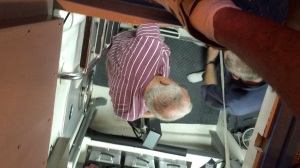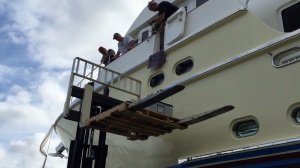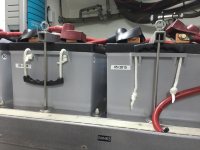April 14, 2015
WARNING: This update is about the “other” side of cruising – boat maintenance! If you are mostly interested in sunsets, rainbows, dolphins, fish, or adventures on the water you may want to skip this and the next couple updates as we are busy doing some boat maintenance. But if you want some of the details, read on!
Many of our projects are still in progress and I will provide a more comprehensive list of more of the things we have done next time. This post will deal with just one project – replacing our house battery bank. What’s that, you may wonder. Well, when the boat is not connected to shore power and we are not running a generator, power for everything – lights, refrigeration, TV, appliances, comes from sixteen large batteries, collectively referred to as the House Battery Bank. When we are at anchor or not at a marina that has shore power for use to connect to, we run a generator twice a day to re-charge these batteries. The batteries themselves are deep-cycle marine batteries, made to be used in this fashion. The life expectancy of these batteries varies but is typically measured in cycles – how many times they are used and re-charged – rather than by years. With the amount of time we spend away from shore power, our four-year old batteries were ready to be replaced.
Our particular batteries are called Lifeline AGM GPL-8DL and each of them weighs 167 pounds. To get to our battery bank, from the Pilot House you go down a set of stairs, then open a hatch, which leads you down a ladder to the Machinery Space (also known as “the hole”). Thus, replacing these batteries isn’t quite like putting a couple new AA’s into your remote control.
First, you have to buy the new batteries. As the price is close to $600 apiece, it pays to shop around a bit. By calling several Lifeline dealers in different states, we were able to be sure we would get the best price and we actually ended up getting them from the dealer in New Bern, NC, though they were shipped to us from the distribution center. The batteries weigh 2600 pounds, so they arrive stacked on a pallet. We had arranged for the use of a forklift to bring them to the boat and to raise them up high enough to unload into the Pilot House (the boat is still out of the water).
The day of installation arrived but there was a problem – heavy rain forecast all day. So we had to postpone until we had better weather. The next day was better and a crew from Offshore Marine Electronics – our local electrical and electronics gurus – arrived ready for a fun day. Soon we found that the forklift came about 2 feet short of reaching the door. So we made a slight alteration to our plan – someone would have to step out onto the pallet to get batteries on and off the boat.
Before starting, protective blankets was laid on the pilot house carpet, blue plastic protective material taped to the stairs, and protective cardboard taped to all walls and bannisters to lessen the possibility of dings to the interior.
Because of a limited staging area, we planned to remove four batteries at a time from the battery bank, lift them out of the hatch, get them up the stairs to the pilot house, bring four new batteries in, get them down the stairs and into the machinery space, then get the old batteries out, onto the pallet, and lowered to the ground. The weight of the batteries meant that lifting straps had to be used to get them out of or into the hatch. The hatch then had to be closed before the batteries could be brought up the steps, and that required coordination between two lifters. Because the forklift didn’t quite get high enough, lifting straps again had to be used to get the batteries onto the pallet. Once the first four were done, the system was working well and was repeated three more times.
All in all, it went pretty smoothly. It took about four hours to get the old batteries off and the new ones in. Soon they were connected up, secured in place and put into service. It was quite a day and I’m sure all the lifters slept well that night!
If you’re still reading at this point, you may even want to watch the video
And here are a few more photos:
- New batteries arrive by forklift
- Old battery coming up through the hatch
- Lifeline AGM Deep Cycle Marine Battery
- Bradley and Steve move one off the boat
- Lowering a new one down the hatch
- A couple new ones come on board
- Clayton connects new batteries
- New batteries installed, connected, secured, and labeled












#1 by Mike smith on April 14, 2015 - 6:11 pm
Kathy, thank you so much for taking the time to make me feel like one of the “crew”, without the back ache! I am a retired Police Detective / retired USCG Boatswainmate-coxswain. When I got out out in 1976 I took a 100 ton license with me. I so look forward to yours and every Nordhavn blog I can get my hands on. I am traveling around the world thanks to you! A retired Detective isn’t in the market for a Nordhavn, but my 27ft cruiser takes me out to the SoCal islands and the Colorado river lakes. Thank you again, God bless and fair seas.
Mike Smith
Mikerdl@aol.com
LikeLike
#2 by Neil Spencer on April 14, 2015 - 6:10 pm
Giday
Thanks for that update. Usual story; we have just replaced the House Battery in Kim’s boat although thankfully he only has need for one.
However, your story prompts me to ask a few questions as those Lifeline/ Lifelink AGMs are bloody good batteries; we use them here and I would have thought that they would have lasted more than four years. That’s about the minimum.
All these question are obvious but I feel duty bound to ask them anyway.
* I would have thought that you would have more than just four batteries; perhaps six. Shenandoah ( Bryan’s old boat) uses two and they really have nothing to power other than the fridge. That brings up the next question:
* Is your Battery Charger configured to charge AGM Batteries? Some are only configured for old lead acid type.
* When you charge up, do you charge up to float voltage ie 13.6 vdc for an AGM (I looked it up)
* If you fitted more House Batteries maybe you wouldn’t need to charge for as long and the batteries would reach float voltage quicker and stay at that voltage longer and you wouldn’t need so many charge cycles and the batteries may last longer.
So, I’m sure your elc guys know what they are doing. Ask Kim if you have any questions as he know all that electrical stuff. I just know the basics; hence the above questions.
All good here; winter is now upon us; the seasons changed in a week and they have gone from a drought in the Sth Island to snow at sea level! It’s a bit cold up here in Auckland; have to now wear UGG boots. Off to Melbourne for the weekend; it’s Suzy’s dads 80th Birthday; he still plays 18 holes of golf once a week.
Have fun on the Hard.
Neil & Suzy
_____
LikeLike
#3 by Bob Danelz on April 14, 2015 - 12:22 pm
Kathy, No warning needed. I love updates like this. At first I was wondering, why up to the pilothouse then down to the hole, but I guess it is the path of least resistance. Is the hole a separate compartment from the engineroom? I had my neighbor help me when I changed the big batteries on my 43 Bayliner. He said, don’t ever ask me again. Times 16 is a very large expense and physical undertaking. Congratulations Bradley and crew!
Nordhavn Dreamer, Bob Danelz Sacramento, CA
LikeLike
#4 by Mark on April 14, 2015 - 11:18 am
You are right it is not a fun day but the knowledge that you have dependable power I am sure gives you peace of mind when you are in the far of places that you go. (167 lbs each wow )…………….Love your videos.
LikeLike
#5 by Chuck McClenon on April 14, 2015 - 10:56 am
y’ know, Kathy, there are some people who love working on cars just for the joy of being under the hood, and then only drive the cars to show off at the auto club gatherings. But I don’t think that’s why many people keep boats, unless they are tall ships.
chuck
>
LikeLike